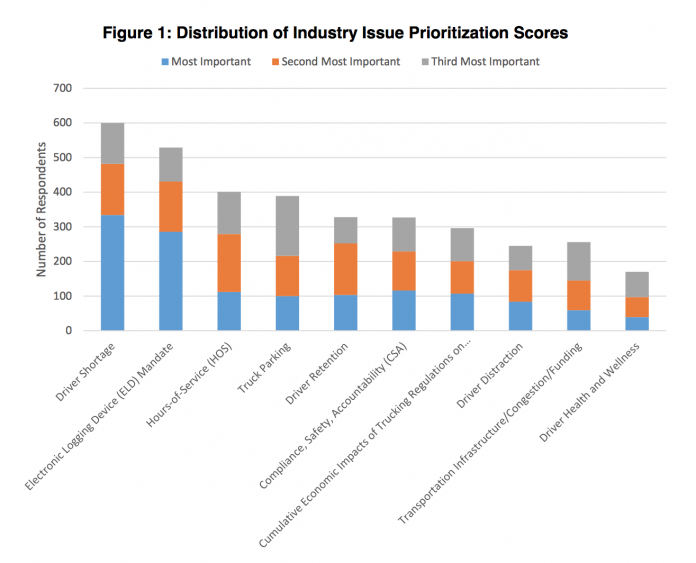The American Transportation Research Institute (ATRI) released its annual list of critical issues in trucking.

ATRI explains their methodology saying, “The issues and potential strategies were first identified by ATRI in collaboration with various trucking stakeholder groups. ATRI then conducted a large-scale survey distribution using its own contact database, ATRI’s regular Sirius/XM radio show, major trucking industry trade press, and through the 50 State Trucking Associations.”
This year’s survey generated 1,557 responses. Approximately 37% of those surveyed identified themselves as truck drivers.
Top 10 Trucking Industry Concerns in 2017
- The Driver Shortage: This is the first time since 2006 that a driver shortage has been voted the number 1 concern in the trucking industry. More than 1,500 industry stakeholders voted in this year’s trucking concern survey – 21 percent said that the driver shortage was their first concern. Another 10 percent ranked it as their second top concern, and 8 percent scored it as their third highest concern.ATRI reports, “The demand for truck drivers will further outpace the supply of qualified drivers.”Efforts to fix the problem: Advocate for state and federal authorities to develop a graduated CDL program to attract safe younger drivers to the industry.
Partner with the U.S. Department of Labor to formalize a national truck driver recruitment program.
Work with the U.S. Department of Transportation and the Department of Defense to equalize and streamline licensing requirements between DOT and DOD. - The ELD Mandate: Eighteen percent of survey respondents said it was their chief industry issue, with 9 percent ranking it second and 6 percent ranking it third. In September of this year, a final effort to delay the ELD mandate by members of the U.S. House of Representatives failed.”FMCSA’s ELD mandate also overcame several last-minute challenges to its implementation, ending a protracted process and ensuring that the mandate will go into effect on December 18, 2017.”Efforts to fix the problem: Research and quantify industry impacts on safety and productivity from full deployment of ELDs.
Assess the landscape of appropriate and inappropriate uses of newly available ELD data.
Ensure that the implementation window is not extended beyond December 2017. - Hours of Service Regulations: HOS has been in the top 3 since 2010.Efforts to fix the problem: Continue to push for increased flexibility in the current sleeper berth provision.
Research and quantify the true safety and economic impacts of customer detention on truck drivers and trucking operations.
Analyze how highly automated technologies could affect the HOS rules and identify what research and data would be necessary to justify future rules changes. - Truck Parking: Lack of truck parking creates a dangerous and costly situation for drivers. With the impending doom that is the ELD mandate, there will need to be an increase of availability of parking, since now drivers will be forced to stop.
Efforts to fix the problem: Support and encourage investment in new truck parking facilities.Educate the public sector on the safety consequences resulting from closing public parking facilities and failing to expand truck parking availability.
Research the role and value of real-time truck parking information availability and truck parking reservation systems. - Driver Retention: “The causes that underpin the growing shortage of commercial drivers and diesel technicians remained firmly in place over the past year, as viable solutions to the pervasive trucking industry staffing challenges have yet to emerge.”Efforts to fix the problem: Study the effectiveness of carrier retention programs that financially incentivize drivers for driving performance in the areas of safety, fuel economy, and trip productivity.
Research the relationship between driver compensation models and driver productivity.
Create an online compendium of retention strategies and best practices, customizable by carrier fleet size and sector.
Compliance, Safety, Accountability (CSA):
Efforts to fix the problem: Actively monitor the deployment of FMCSA’s crash accountability pilot program to evaluate success in removing non-preventable crashes from carrier scores.
Work with FMCSA to ensure that the recommendations of the Congressionally- mandated National Academies of Sciences review of CSA are successfully implemented.
Advocate for CSA score reductions in existing BASICs rather than a new BASIC for carriers who choose to participate in FMCSA’s Beyond Compliance programCumulative Economic Impacts of Trucking Regulations on the Industry:
Efforts to fix the problem: Evaluate the government’s projected industry costs found in federal agency regulatory impact analyses against real-world industry costs that accrue from the new regulations.
Quantify cumulative regulatory net costs incurred by the trucking industry over the past decade, broken out by each federal agency promulgating the regulations.
Develop recommended industry metrics and an improved Regulatory Impact Analysis model for future rulemakings to better project industry costs.- Driver Distraction: Safety is always key.
Efforts to fix the problem: Encourage harsher penalties and more aggressive enforcement of distracted driving violations for drivers of all vehicle types.
Advocate for a national standard for distracted driving laws for all motorists.Recognizing the growing role of onboard technologies, identify solutions that support safe technology usage in the cab.
- Infrastructure and Congestion: “Poorly maintained roads and traffic congestion create wear and tear on vehicles, waste fuel and increase emissions, create additional stress for drivers, and negatively impact industry productivity.”
Efforts to fix the problem: Continue to advocate for long-term highway funding through an increase in the fuel tax or other user fees, and prevent additional diversion of revenue to non-highway projects.
Create a new funding program to focus federal resources on truck bottlenecks on major freight routes.
Utilize the Congressionally-mandated National Freight Policy and National Freight Network as tools to ensure adequate investment in critical highway infrastructure. - Driver Health and Wellness: The trucking industry wants its driver happy, healthy, and well.
Efforts to fix the problem: Encourage increased availability of exercise facilities and healthy food choices at truck stops/travel plazas.
Continue industry data collection and analysis on driver health-related issues to ensure that any future regulatory actions are based on recent and best available data.
Undertake research that quantifies the return-on-investment potential of driver health and wellness programs.Compare this year’s results to years past:

